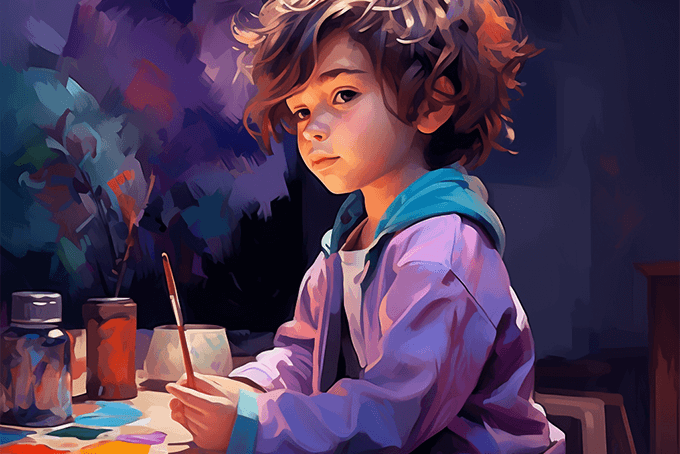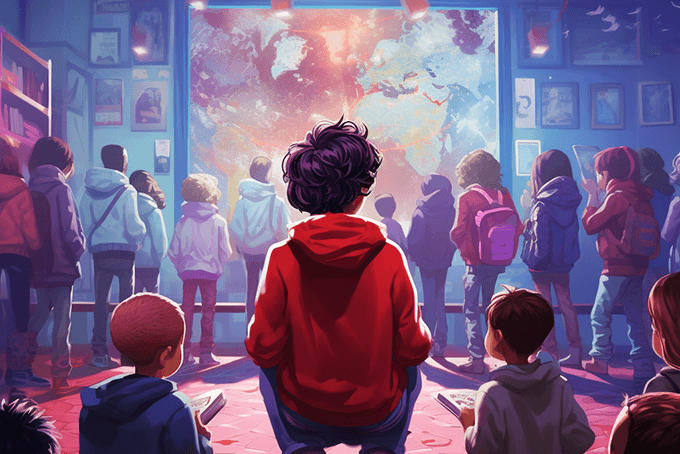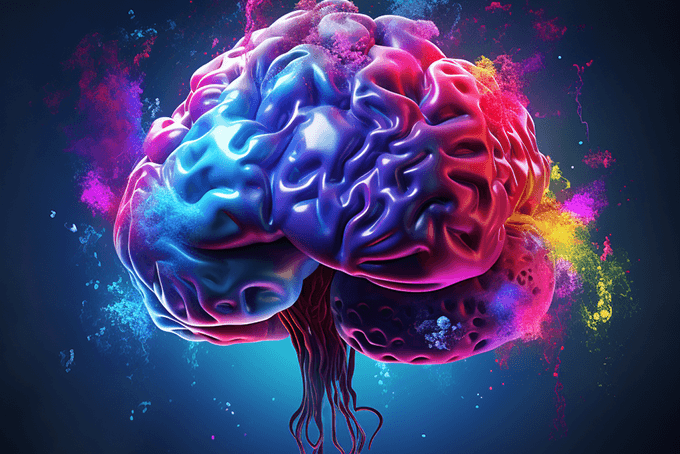Left-brain art activities don’t have to be boring – they can be filled with exciting ways for enticing kids to tap into the benefits of combining the sides of their brains into one fun creative machine. Often, kids let their dominant left-brain take charge forgetting their creative right-brain completely, leading to comments such as, “I can’t draw.” Encouraging creative left-brain art activities promotes self-confidence and the child’s brain to work together.
Children Aged 2 to 4
Young kids greatly benefit from activities that engage the left-brain in creative art projects. Introduce kids to shapes along with the math concept of pattern through a fun water resist art activity.
- Look at patterns with the child and discuss how they are created. The left-brain is encouraged when the big picture is looked at instead of the small parts of a project.
- Offer him a sheet of white drawing paper and a set of crayons. Younger children can enjoy the process of engaging their logical left-brain through creating simple shapes, while older toddlers can attempt to create patterns using both colors and shapes.
- Remove the crayons once he’s finished making patterns. The child can now paint all over their paper using watercolors, practicing dipping his paintbrush into the paints on his own, developing his fine-motor skills. Invite him to paint without concern for staying within lines or following any set directions, allowing his creative right-brain to coordinate with his left.
- Discuss the finished artwork together further engaging the child’s visual cortex and his creative development. Talk about what he liked about the art making process and encourage him to explain his finished patterns.
Children Aged 5 to 7
As children age and become more critical of their artwork, encouraging left-brain art reminds them that their artwork doesn’t have to solely rely on creativity but can be accomplished through using their left-brain skills, too. Create a geometric design with kids encouraging their basic math knowledge as well as their artistic skills.
- Discuss geometric shapes with the child, having him draw pictures of as many as he can and then write the names of the shapes, further engaging his left-brain.
- Invite the child to select three shapes to use for his geometric design.
- Give the child a sheet of white drawing paper and have him draw the first shape he selected with a marker so that it almost touches the sides of the paper. Offer him the use of a ruler to help create his lines. Then he can draw the second shape within the first, and the third within the second shape, making his three shapes all within each other.
- The child can now use markers to color each shape in, using a different color for each shape.
Children Aged 8 to 13
Older children begin to lose interest in art as they age and due to art not being included in many middle schools and high schools as a required subject. Preteens are at risk of missing out on honing their creative skills and finding ways to remind their brains that merging their right and left-brain talents help form a complete human being. Challenge kids by creating a 3D sculpture from a piece of construction paper.
- Provide the child with an 8 by 10-inch piece of construction paper and invite him to figure out a way to create a freestanding 3-dimensional form using solely the paper and a pair of scissors.
- Look at modern sculptures by the American artist David Smith, and discuss how he came up with the motivation to make the interesting forms. Discussing artwork stimulates the visual cortex and promotes use of the right brain.
- Brainstorm ideas for how the child can create the sculpture. Working through the problem to find a solution gets the left-brain kick started and ready for the challenge.
- Encourage the child to fold, cut, and shape the flat paper into a form that is able to stand on its own without support.
Young Adults
Once kids hit young adulthood, they become aware of their inabilities in the area of the arts. Most lean toward the feeling they aren’t creative, where in reality their creativity is hiding out in their right-brain. By creating a mathematical grid drawing a child is able to easily and comfortably recreate an image without fear of mistake or disappointment along with reminding them of their tucked away creativity.
Chuck Close is an American artist that uses mathematical grids to recreate photographs into larger than life portraits using pointillism. Look at examples of his work with the teenager and discuss his techniques.
- Invite him to find an image from a magazine or an actual photograph to recreate in the style of Chuck Close.
- Using a ruler and some basic math, he can figure out how to enlarge the small image onto a larger piece of paper. For instance, if the photograph he selects is 4 by 6-inches, he can create a grid with marker lines every 2-inches around the image. The small 4 by 6-inch image can be enlarged onto a 12 by 18-inch piece of paper with a grid drawn lightly in pencil every 6-inches around the paper.
- He can use markers to recreate the image using large and small dots of color, encouraging the left-brain to work methodically from one square to the next in the grid formation.
- Due to the left-brain not feeling challenged to create a realistic image, the right brain is able to offer a helping hand, which allows the teenager’s artistic abilities to shine through without him even realizing it.
By encouraging kids to use their left-brain and their inner creativity, they will feel confident about their artwork and also feel ready to share their creativity with others.



